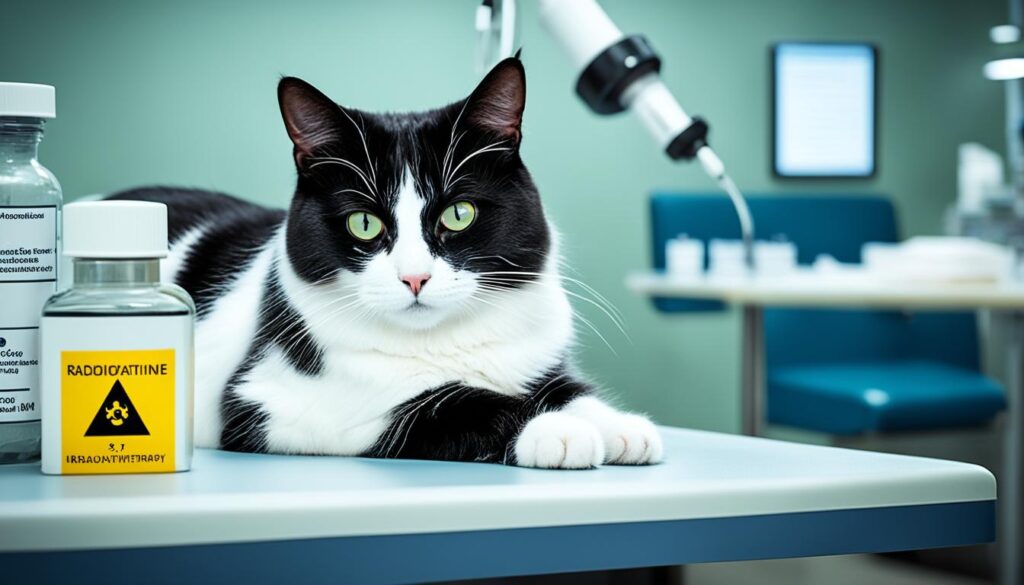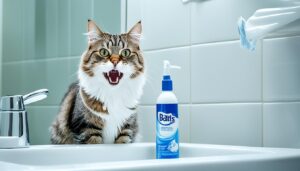Did you know that hyperthyroidism is the most common endocrine disorder in cats, affecting about 10% of the feline population? This alarming statistic highlights the importance of understanding and managing this condition in our beloved feline companions. Hyperthyroidism, characterized by an overactive thyroid gland, can lead to a range of symptoms and complications if left untreated.
Key Takeaways:
- Hyperthyroidism is a prevalent disease in cats, affecting approximately 10% of the feline population.
- An overactive thyroid gland causes hyperthyroidism, resulting in various symptoms and potential complications.
- Prompt diagnosis and appropriate management are crucial for ensuring the well-being of cats with hyperthyroidism.
- Treatment options for hyperthyroidism in cats include medication, radioactive iodine therapy, surgery, and dietary therapy.
- Regular monitoring and follow-up care are essential for maintaining the effectiveness of treatment and addressing any secondary complications.
What is Hyperthyroidism in Cats?
Hyperthyroidism is a disease characterized by the overproduction of thyroid hormone in cats. This condition leads to an increased metabolic rate and can result in various clinical signs. The thyroid gland, located in the neck, plays a vital role in regulating the body’s metabolic rate and affecting many bodily processes. Hyperthyroidism is most commonly observed in older cats and is often caused by a benign tumor in the thyroid gland.
Common signs of hyperthyroidism in cats include:
- Weight loss
- Increased appetite
- Poor body condition
- Vomiting
- Diarrhea
- Increased thirst and urination
- Restlessness
- Enlarged thyroid gland
Hyperthyroidism can significantly impact a cat’s overall health and well-being. Detecting and managing this condition is crucial for the cat’s quality of life. Understanding the signs and underlying causes of hyperthyroidism is essential in facilitating early diagnosis and effective treatment.
Causes of Hyperthyroidism in Cats
The exact cause of feline hyperthyroidism is unknown, but there are several theories and potential contributing factors. One theory suggests that environmental factors, such as exposure to certain chemicals or flame retardants, may play a role. Another theory implicates dietary factors, particularly high levels of iodine in the diet. There may also be a genetic predisposition, although no specific breed has been identified as being more susceptible. Further research is needed to fully understand the causes of hyperthyroidism in cats.
To better understand the potential causes of feline hyperthyroidism, let’s explore the main theories and factors:
- Environmental factors: Certain chemicals or flame retardants found in the environment may contribute to the development of hyperthyroidism in cats. These substances can disrupt the normal function of the thyroid gland, leading to overproduction of thyroid hormones.
- Dietary factors: High levels of iodine in the diet have been associated with an increased risk of developing hyperthyroidism in cats. Iodine is an essential nutrient for proper thyroid function, but excessive amounts can disrupt the balance and lead to overactive thyroid glands.
- Genetic predisposition: While feline hyperthyroidism can affect cats of any breed, there may be a genetic component that makes certain cats more susceptible to the disease. However, no specific breed has been definitively identified as being more prone to developing hyperthyroidism.
Research into the causes of feline hyperthyroidism is ongoing, as scientists strive to uncover the underlying mechanisms and contributing factors. Understanding the causes can help veterinarians develop more effective strategies for prevention, diagnosis, and treatment.
| Possible Causes of Feline Hyperthyroidism | Description |
|---|---|
| Environmental factors | Exposure to certain chemicals or flame retardants may contribute to the development of hyperthyroidism in cats. |
| Dietary factors | High levels of iodine in the diet have been associated with an increased risk of hyperthyroidism in cats. |
| Genetic predisposition | While no specific breed has been identified, there may be a genetic component that makes certain cats more susceptible to hyperthyroidism. |
Diagnosis of Hyperthyroidism in Cats
The diagnosis of hyperthyroidism in cats involves a comprehensive approach that includes a physical examination, blood tests, and evaluation of thyroid hormone levels. As a veterinarian, I employ these diagnostic methods to accurately identify and confirm hyperthyroidism in feline patients.
During the physical examination, I carefully palpate the cat’s neck to check for an enlarged thyroid gland. This palpation allows me to gather important information about the size and texture of the gland, aiding in the diagnosis of hyperthyroidism.
Additionally, I assess the cat’s heart rate and blood pressure as elevated levels can sometimes be indicative of hyperthyroidism. This assessment, along with other clinical signs, helps me determine the severity of the disease and guide treatment decisions.
To further evaluate the cat’s overall health, I perform various blood tests, including a complete blood count and a chemistry panel. These tests provide valuable insights into the cat’s organ function and overall well-being.
Measurement of thyroid hormone levels, specifically T4, is crucial for confirming the diagnosis of hyperthyroidism. Elevated T4 levels are a strong indicator of the disease, while normal or low levels can help rule out hyperthyroidism as a potential cause of the cat’s symptoms.
In some cases, additional tests or a referral for a thyroid scan may be necessary for a definitive diagnosis. These tests can provide more detailed information about the cat’s thyroid function and aid in treatment planning.
| Diagnostic Methods | Advantages |
|---|---|
| Physical examination | Allows for the evaluation of the thyroid gland size and texture. |
| Blood tests | Provides insights into overall health and organ function. |
| T4 Measurement | Confirms the diagnosis of hyperthyroidism. |
| Additional tests or thyroid scan | Provide further information about thyroid function. |
With a thorough diagnostic approach, I can accurately diagnose hyperthyroidism in cats and tailor treatment plans to meet the unique needs of each patient.
Treatment Options for Hyperthyroidism in Cats
When it comes to managing hyperthyroidism in cats, there are several treatment options available. The best treatment choice will depend on the individual cat’s overall health and the owner’s ability to administer treatment regularly. Here are the main treatment options for feline hyperthyroidism:
1. Medication
One of the most common treatment options for hyperthyroidism in cats is medication. Anti-thyroid drugs, such as methimazole, can help control the production and release of thyroid hormone from the enlarged thyroid gland. While medication can effectively manage hyperthyroidism, it does not provide a cure. Regular blood tests are required to monitor the cat’s hormone levels and adjust the medication dose if necessary. It is important to note that medication must be given regularly and for the rest of the cat’s life to effectively control the disease. Some cats may experience side effects from the medication, such as vomiting, anorexia, fever, anemia, and lethargy.
2. Radioactive Iodine Therapy
Radioactive iodine therapy, also known as I-131 treatment, is considered the treatment of choice for hyperthyroidism in cats. It involves administering a radioactive form of iodine that is selectively taken up by the abnormal thyroid tissue, destroying it without affecting other healthy tissues. Radioactive iodine therapy is highly effective and can often cure hyperthyroidism. The treatment is typically performed at specialized veterinary facilities due to its radioactive nature. Cats will need to be hospitalized for several days after treatment to allow the radioactive material to dissipate. While radioactive iodine therapy carries no significant risk for the cat, precautions are necessary for people who come into close contact with the cat during the quarantine period.
3. Surgery
Surgical removal of the affected thyroid gland is another treatment option for hyperthyroidism in cats. This procedure, known as surgical thyroidectomy, can provide a long-term or permanent cure for hyperthyroidism. However, surgery requires general anesthesia and carries the risk of complications, particularly in older cats with underlying health issues. Surgery is usually reserved for cases where other treatment options are not feasible or preferred. Rarer cases of hyperthyroidism involving thyroid cancer may require more extensive surgery to remove cancerous tissue.
4. Dietary Therapy
Dietary therapy involves feeding a restricted iodine diet to manage hyperthyroidism in cats. By reducing iodine intake, the treatment aims to control the disease. Feeding a diet low in iodine may be a viable option for cats with medical conditions that prevent other treatment options. However, the long-term effects of dietary therapy on overall health are still being studied, and it is important to discuss the potential benefits and risks with your veterinarian.
Here is a summary of the different treatment options:
| Treatment Option | Advantages | Considerations |
|---|---|---|
| Medication | – Can effectively control hyperthyroidism – Non-invasive – Regular blood tests can monitor hormone levels – Can be administered at home |
– Does not provide a cure – Lifelong treatment required – Potential side effects |
| Radioactive Iodine Therapy | – Often cures hyperthyroidism – Highly effective – Selectively targets abnormal thyroid tissue – Minimal risks for the cat |
– Requires hospitalization and quarantine period – Specialized facilities are needed – Precautions for people in close contact with the cat |
| Surgery | – Can provide a long-term or permanent cure – Removes the affected thyroid gland – No lifelong medication required |
– Requires general anesthesia – Risk of complications, especially in older cats – Reserved for cases where other options are not feasible |
| Dietary Therapy | – May be suitable for cats with medical conditions – Can help control iodine intake – Non-invasive |
– Long-term effects still being studied – Potential limitations in nutritional variety |
It is crucial to consult with a veterinarian to determine the most appropriate treatment option for your cat. They will consider the cat’s specific condition, overall health, and individual needs to create a tailored treatment plan for managing hyperthyroidism.
Medication for Hyperthyroidism in Cats
Medication is a common treatment option for managing hyperthyroidism in cats. Anti-thyroid drugs, such as methimazole, are commonly prescribed to control the disease. These medications work by reducing the production and release of thyroid hormone from the thyroid gland.
While medication does not provide a cure for hyperthyroidism, it can help control the disease and alleviate the associated symptoms. In order to effectively manage hyperthyroidism, medication must be given regularly and for the cat’s lifetime.
It is important to note that some cats may experience side effects from medication. These can include vomiting, anorexia, fever, anemia, and lethargy. If any concerning side effects occur, it is crucial to contact your veterinarian immediately.
Regular blood tests are necessary to monitor the effectiveness of the medication and to check for potential side effects. These tests help ensure that the dosage is appropriate and that the cat’s thyroid hormone levels are within the target range.
Radioactive Iodine Therapy for Hyperthyroidism in Cats

Radioactive iodine therapy, also known as I-131 treatment, is considered the gold standard therapy for hyperthyroidism in cats. It is a highly effective treatment that often cures hyperthyroidism completely. This therapy involves administering a radioactive form of iodine that is specifically absorbed by the thyroid gland, targeting and destroying the abnormal tissue responsible for the overproduction of thyroid hormones.
Performed at specialized veterinary facilities, radioactive iodine therapy offers several advantages. It is a non-invasive treatment that does not require anesthesia or surgery. Instead, a single injection or a capsule containing the radioactive iodine is given to the cat, allowing the radioactive material to be absorbed by the thyroid gland.
After receiving the treatment, cats will need to be hospitalized for several days to ensure adequate time for the radioactive material to dissipate. This is done to protect both the cat and individuals who may come into close contact with the cat during the quarantine period after treatment.
Advantages of Radioactive Iodine Therapy
Radioactive iodine therapy offers distinct benefits compared to other treatment options for feline hyperthyroidism. Some key advantages include:
- High success rate in curing hyperthyroidism
- Long-term remission without the need for continued medication
- Non-invasive treatment, avoiding the risks associated with surgery
- Minimal side effects, particularly when compared to medications
- Targeted treatment that specifically destroys abnormal thyroid tissue
Additionally, radioactive iodine therapy allows for the preservation of normal thyroid tissue, ensuring that the cat maintains normal thyroid function without the risk of hypothyroidism, which can occur with surgical removal of the thyroid gland.
Cost Considerations
While radioactive iodine therapy offers significant benefits, it is important to note that it may come with a higher upfront cost compared to other treatment options. The specialized nature of the treatment, the need for hospitalization, and the fact that it is administered by trained professionals contribute to the overall cost. However, when considering the long-term benefits and the potential for a complete cure, many cat owners find that radioactive iodine therapy provides a cost-effective solution.
Monitoring and Follow-up Care
Following radioactive iodine therapy, cats will require regular monitoring to ensure that their thyroid hormone levels remain within the normal range. This typically involves periodic blood tests to assess thyroid function. Monitoring may also include an evaluation of the cat’s overall health and the presence of any secondary complications that may arise.
Comparison of Treatment Options for Hyperthyroidism in Cats
| Treatment Option | Advantages | Considerations |
|---|---|---|
| Radioactive Iodine Therapy | – High cure rate – Long-term remission – Targeted treatment |
– Specialized facilities – Hospitalization required |
| Medication | – Control of symptoms – Non-invasive |
– Lifelong administration – Potential side effects |
| Surgery | – Potential for a permanent cure | – Anesthesia and risks associated with surgery |
| Dietary Therapy | – Non-invasive – Low iodine intake |
– Controversial efficacy – Long-term effects unknown |
Surgery for Hyperthyroidism in Cats
Surgical removal of the affected thyroid gland is another treatment option for hyperthyroidism in cats. The surgery, known as surgical thyroidectomy, can provide a long-term or permanent cure for hyperthyroidism. However, it requires general anesthesia and carries the risk of complications, particularly in older cats with underlying health issues. Surgery is usually reserved for cases where other treatment options are not feasible or preferred. Rarer cases of hyperthyroidism involving thyroid cancer may require more extensive surgery to remove cancerous tissue.
During surgery for hyperthyroidism in cats, the veterinarian will make an incision in the neck to gain access to the thyroid gland. The affected thyroid lobe or lobes will be carefully removed, taking care to preserve adjacent structures, such as the parathyroid glands and blood vessels. The remaining healthy thyroid tissue is usually sufficient to maintain normal thyroid function.
After surgery, cats will require post-operative care and monitoring to ensure proper healing and recovery. Pain management may be necessary to keep the cat comfortable during the healing process. The veterinarian will provide specific instructions on how to care for your cat after surgery, including guidelines for wound care, feeding, and medication administration if needed.
It is important to note that surgery for hyperthyroidism is not without risks. Complications that can occur include bleeding, infection, damage to adjacent structures, and hypothyroidism (underactive thyroid) if too much thyroid tissue is removed. The risks and benefits of surgery should be carefully considered in consultation with your veterinarian.
Benefits and considerations of surgery for hyperthyroidism in cats:
- Benefits:
- Long-term or permanent cure for hyperthyroidism
- Potential elimination of the need for lifelong medication or radioactive iodine therapy
- Immediate reduction in thyroid hormone levels
- Considerations:
- Requires general anesthesia and carries the risk of complications
- More invasive than other treatment options
- May require hospitalization and post-operative monitoring
- Not suitable for all cats, particularly those with underlying health issues or significant thyroid enlargement
If surgery is recommended as the treatment option for your cat’s hyperthyroidism, it is important to discuss the procedure, potential risks, and expected outcomes with your veterinarian. They will be able to provide personalized guidance based on your cat’s specific condition and overall health.
Dietary Therapy for Hyperthyroidism in Cats

Dietary therapy is one of the treatment options available for cats with hyperthyroidism. It involves feeding a restricted iodine diet to manage the condition and help control the overproduction of thyroid hormone. By limiting the cat’s intake of iodine, which is essential for the production of thyroid hormone, dietary therapy aims to reduce the stimulation of the thyroid gland and slow down the progression of the disease.
Feeding a diet low in iodine can be a viable option for cats with medical conditions that prevent other treatment options, such as medication or surgery. It provides an alternative approach to managing hyperthyroidism and can be particularly beneficial for cats who may not tolerate medication or cannot undergo surgery due to their health status.
However, it’s important to note that dietary therapy for hyperthyroidism in cats is somewhat controversial. While it can help control the disease, its long-term effects on overall health are still being studied. It is recommended to discuss the potential benefits and risks of dietary therapy with your veterinarian before implementing it as a treatment option for your cat.
| Dietary Therapy for Hyperthyroidism in Cats: | |
|---|---|
| Advantages | Considerations |
|
|
Please remember that dietary therapy alone may not be sufficient to manage hyperthyroidism in all cases. Regular monitoring and follow-up care are necessary to ensure the effectiveness of the treatment and address any potential complications or changes in the cat’s condition.
Secondary Problems and Prognosis of Hyperthyroidism in Cats
Hyperthyroidism in cats can lead to several secondary problems, including heart disease and high blood pressure. The excessive production of thyroid hormones can cause changes in the heart, resulting in the thickening of the heart muscle and an increased heart rate. Hypertension, or high blood pressure, is another potential complication of hyperthyroidism that can damage multiple organs.
It is crucial to address these secondary problems to ensure the well-being of cats with hyperthyroidism. Treatment for heart disease and high blood pressure may be necessary alongside the management of hyperthyroidism. However, once the underlying hyperthyroidism is controlled through appropriate therapy, these complications often improve or resolve.
With proper management and diligent medical care, the prognosis for cats with hyperthyroidism is generally good. However, it’s essential to consider the presence of other organ diseases, as they may affect the overall prognosis. Regular monitoring, follow-up visits with the veterinarian, and adherence to treatment plans will help ensure the best possible outcome for cats with hyperthyroidism.
Image:
| Secondary Problems of Hyperthyroidism in Cats | Treatment |
|---|---|
| Heart Disease | Medication, dietary management, and regular monitoring |
| High Blood Pressure | Medication, dietary management, and regular monitoring |
Conclusion
Hyperthyroidism is a common disease in cats, particularly among middle-aged and older cats. This condition, characterized by the overproduction of thyroid hormone, can lead to various clinical signs and secondary complications. Early diagnosis and appropriate treatment are crucial for managing hyperthyroidism and enhancing the quality of life for affected cats.
When it comes to managing hyperthyroidism in cats, there are several treatment options available. Medication, such as methimazole, can help control the disease, although lifelong administration is necessary. Radioactive iodine therapy, considered the gold standard treatment, offers a potential cure for hyperthyroidism in most cases. Surgical removal of the affected thyroid gland and dietary therapy are also viable options that should be considered based on the cat’s overall health and the owner’s ability to administer treatment regularly.
Regular monitoring and follow-up care are essential in managing hyperthyroidism in cats. This includes periodic check-ups, blood tests, and evaluation of thyroid hormone levels to ensure the effectiveness of treatment and detect any potential secondary complications. With proper management and treatment, cats with hyperthyroidism can lead happy and healthy lives.
FAQ
What are the signs of hyperthyroidism in cats?
What causes hyperthyroidism in cats?
How is hyperthyroidism in cats diagnosed?
What are the treatment options for hyperthyroidism in cats?
How does medication help manage hyperthyroidism in cats?
What is radioactive iodine therapy for hyperthyroidism in cats?
Is surgery an option for treating hyperthyroidism in cats?
What is dietary therapy for hyperthyroidism in cats?
Can hyperthyroidism in cats lead to secondary problems?
What is the prognosis for cats with hyperthyroidism?
References
| International Body | Website |
| International Cat Association (TICA) | https://www.tica.org/ |
| The Cat Fanciers’ Association (CFA) | https://cfa.org/ |
| World Cat Federation (WCF) | https://www.wcf-online.de/ |
| Fédération Internationale Féline (FIFe) | https://www.fifeweb.org/ |
| Governing Council of the Cat Fancy (GCCF) | https://www.gccfcats.org/ |








[…] biting can be a sign of underlying medical issues or stress in your cat’s life. Consult with a veterinarian to rule out any medical causes and discuss possible stressors in […]
[…] observe your cat for any signs of discomfort, swelling, redness, or discharge around the incision site. These may indicate an […]
[…] they are most active during the twilight hours of dawn and dusk. Understanding the sleep habits of cats can help pet owners better manage their nighttime activities and ensure a harmonious sleep routine for both feline and […]
[…] a cat enters the heat cycle, there are several behavioral changes that owners may observe. These signs indicate that the cat is in a fertile period and seeking a […]
[…] their health is crucial for their well-being. In this article, I will guide you through the signs of fever in cats, how to check your cat’s temperature, the causes of fever, and what to do if your cat is […]
[…] low tail position can be a sign of fear or anxiety in cats. When a cat tucks its tail between its hind legs or holds it close to the ground, it suggests that […]
[…] are several signs that indicate your cat remembers you. Cats have a strong sense of smell and can recognize your scent, often sniffing you […]
[…] to understanding their emotional well-being and ensuring appropriate care. Here are some common signs of cat distress when left […]
[…] have diarrhea, or feel very weak. In bad cases, it could even damage their liver. If you see these signs in your cat, you should act […]
[…] Completion: Cats may show signs of improvement before the prescribed treatment duration is completed. However, discontinuing […]
[…] cat body language is essential for identifying signs of […]
[…] Signs of arthritis in cats include difficulty getting up and down, stiff and swollen joints, loss of appetite, and behavior changes. […]